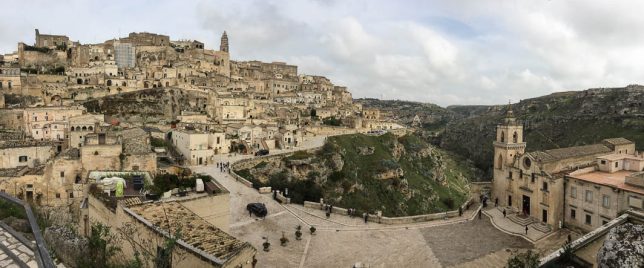 The weekend of November 1st was a long holiday weekend, so Stefano and I, and his aunt and uncle (yes, the uncle with MM), decided to visit the ancient southern Italian city of Matera, designated as a UNESCO World Heritage Site in 1993. It is also one of the OLDEST CONTINUOUSLY INHABITED cities in the entire world. How about that, eh!
The weekend of November 1st was a long holiday weekend, so Stefano and I, and his aunt and uncle (yes, the uncle with MM), decided to visit the ancient southern Italian city of Matera, designated as a UNESCO World Heritage Site in 1993. It is also one of the OLDEST CONTINUOUSLY INHABITED cities in the entire world. How about that, eh!
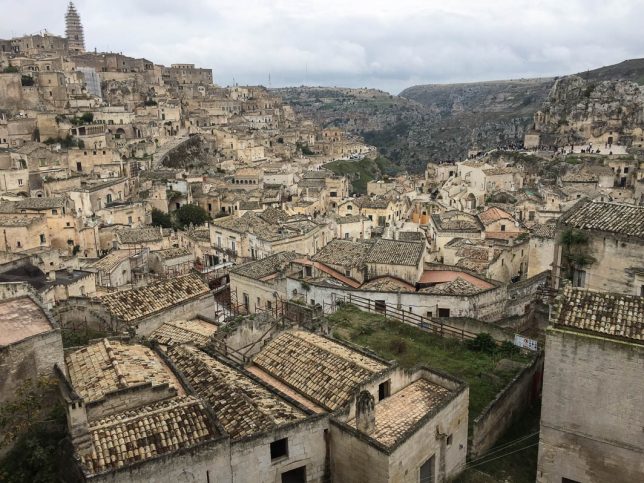 In 2014, Matera was also awarded the title of 2019 European city of culture and since then has become a big tourist attraction. By the time we managed to book a B&B, in fact, Matera was 97% booked!
In 2014, Matera was also awarded the title of 2019 European city of culture and since then has become a big tourist attraction. By the time we managed to book a B&B, in fact, Matera was 97% booked!
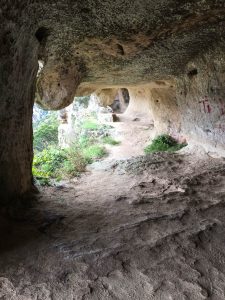 Matera is mainly famous for its Sassi (Italian for “Stones”), for its 1500 cave dwellings carved out of limestone and scattered all over the flanks of a steep ravine. These caves, dating to the Paleolithic (see photo on right), were expanded into slightly larger dwellings (the Sassi) by peasants and artisans in later eras. We visited one of the most famous cave dwellings inside the Sassi, but there were too many tourists inside to take any decent photos…You can look it up online, if you are curious. It’s called “Casa Grotta di Vico Solitario.” The cave on the right is much more ancient (no doors, e.g.!), and located in the Murgia National Park, that is, outside the Sassi. In the photo below you have a panoramic view of these more ancient caves…
Matera is mainly famous for its Sassi (Italian for “Stones”), for its 1500 cave dwellings carved out of limestone and scattered all over the flanks of a steep ravine. These caves, dating to the Paleolithic (see photo on right), were expanded into slightly larger dwellings (the Sassi) by peasants and artisans in later eras. We visited one of the most famous cave dwellings inside the Sassi, but there were too many tourists inside to take any decent photos…You can look it up online, if you are curious. It’s called “Casa Grotta di Vico Solitario.” The cave on the right is much more ancient (no doors, e.g.!), and located in the Murgia National Park, that is, outside the Sassi. In the photo below you have a panoramic view of these more ancient caves…
Anyway, the dank and dark Sassi dwellings were still inhabited in the middle of last century by as many as 15,000 people. Each family lived together with its animals, usually chickens, a donkey, and a pig. The above-mentioned Vico Solitario dwelling was inhabited by a family of 11, we were told. So many people, living under those conditions…no ventilation, dampness that made your bones creak, no running water, no electricity, no sewer system…Just one double bed for the entire family, and a tiny crib, which meant that the older children were sleeping on boxes or on some hay spread out on the floor…
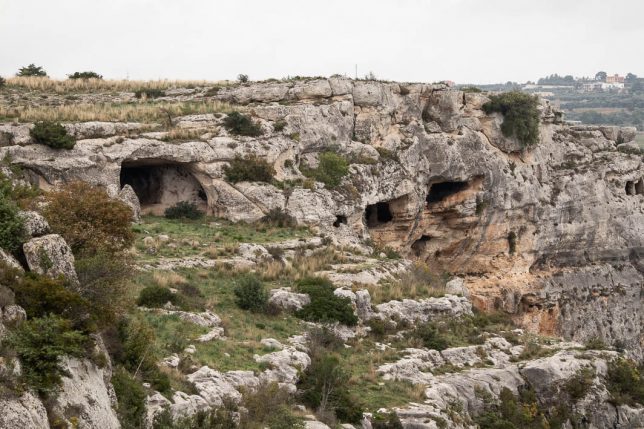 It’s no wonder that malaria, cholera, typhoid were common diseases in Matera. We were told that child mortality was at 50%. I’m surprised that number wasn’t higher…
It’s no wonder that malaria, cholera, typhoid were common diseases in Matera. We were told that child mortality was at 50%. I’m surprised that number wasn’t higher…
Then, in the mid 1950s, the Italian government declared that Matera was “the shame of Italy” and had all of the Sassi’s inhabitants relocated to public housing projects in the modern part of Matera. This move, although necessary, I suppose, unfortunately destroyed an entire social network…And in fact the inhabitants didn’t want to leave their homes, their neighbors, their livelihoods. They had to be forcefully removed. The relocated children of the “Sassi” then pretended that they’d come from other parts of the region. The Sassi at that time was synonymous with abysmal poverty, ignorance, etc. Who’d want to be associated with that?
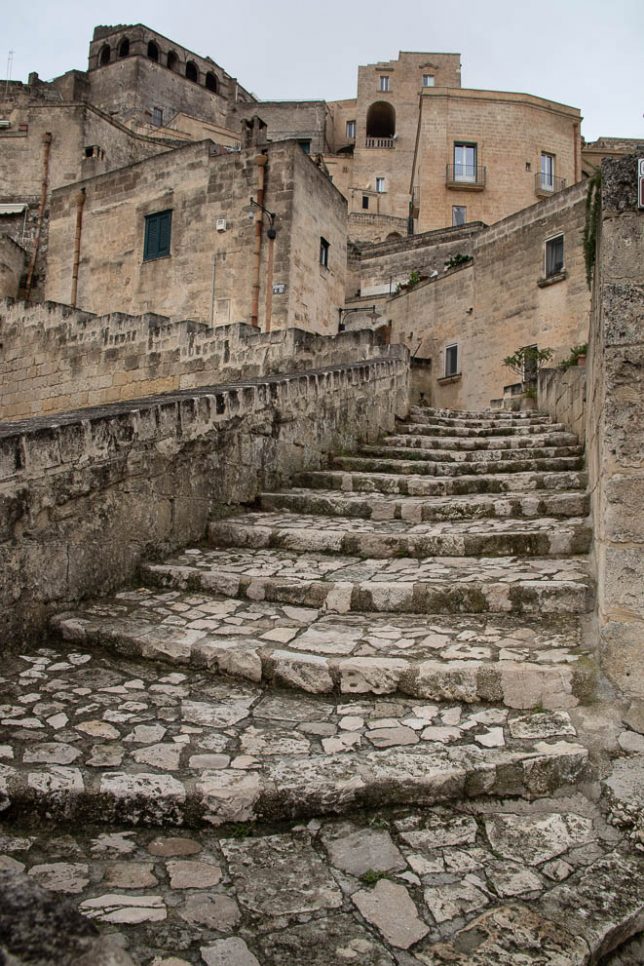 After this relocation, the Sassi were essentially left to rot…until 30 years later. In the 1980s, the local administration realized Matera’s tourism potential and began fixing up the ancient buildings and promoting the Sassi…
After this relocation, the Sassi were essentially left to rot…until 30 years later. In the 1980s, the local administration realized Matera’s tourism potential and began fixing up the ancient buildings and promoting the Sassi…
Ancient caves have now been turned into fancy boutique hotels, restaurants, galleries, and even a contemporary art museum, MUSMA, that has its own underground network. As I was looking online for a reasonably-priced B&B, I came across a fancy hotel that offered a fancy suite with a fancy (amazing!) underground swimming pool. We didn’t go there, but it gave us an idea of the sort of change that Matera has undergone in the past few decades…Now it’s a hip place to go!
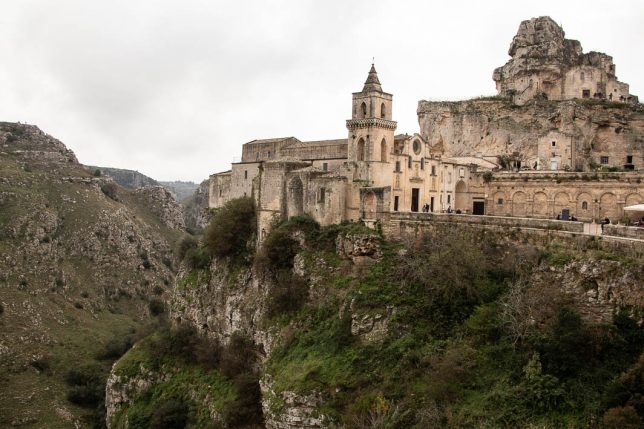 Unfortunately, it rained, and rained and rained, during most of our stay, which certainly added to Matera’s aura of mystery and, well, a bit of spookiness, too…But when, on the day we left (!), the sun came out, all I could say was “WOW!” The sun really made a difference…
Unfortunately, it rained, and rained and rained, during most of our stay, which certainly added to Matera’s aura of mystery and, well, a bit of spookiness, too…But when, on the day we left (!), the sun came out, all I could say was “WOW!” The sun really made a difference…
Beautiful!
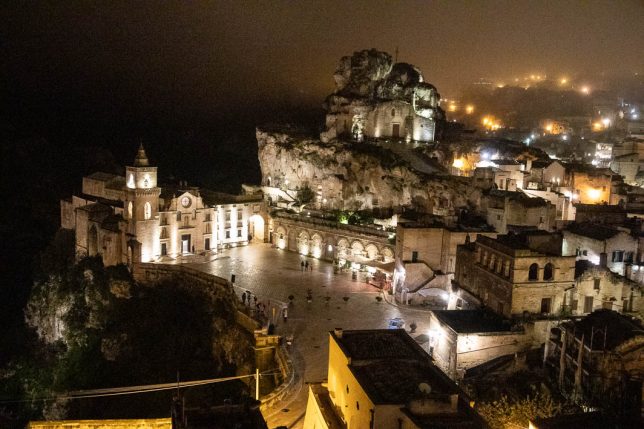 Oh, we also ate incredibly well in restaurants that I’d chosen because they used locally-sourced food…amazing…so YUMMY! We brought back with us some of the specialties we had enjoyed in Matera, including black chickpeas, which are grown in the Murgia National Park, located on the other side of the gorge.
Oh, we also ate incredibly well in restaurants that I’d chosen because they used locally-sourced food…amazing…so YUMMY! We brought back with us some of the specialties we had enjoyed in Matera, including black chickpeas, which are grown in the Murgia National Park, located on the other side of the gorge.
Black chickpeas apparently contain lots of iron. 🙂 They have to be soaked for two days, then boiled for three and a half hours. Wowsie! But they are so yummy…
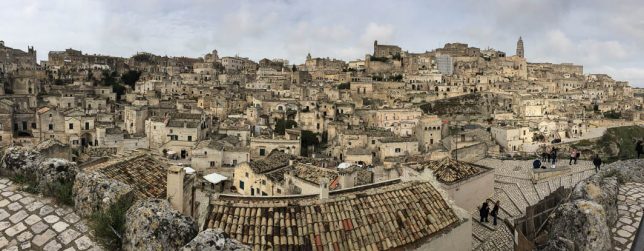 Oh, I guess it’s obvious that I am compleeeeeetely over my bronchial pneumonia…I have to admit that I still get tired easily, but…no big deal. I’m taking probiotics (after such heavy doses of antibiotics, probiotics are a MUST), as well as vitamins and minerals to boost my energy levels. All good!
Oh, I guess it’s obvious that I am compleeeeeetely over my bronchial pneumonia…I have to admit that I still get tired easily, but…no big deal. I’m taking probiotics (after such heavy doses of antibiotics, probiotics are a MUST), as well as vitamins and minerals to boost my energy levels. All good!
Anyway, if you are ever in or near the region of Basilicata, do stop in Matera…It’s well worth the visit. Oh, and don’t forget to visit the cave-churches with their amazing frescos dating as far back as the 9th century.
And one more thing: if it rains during your visit, please be careful, VERY careful!!!, as you walk down the slippery steps of the Sassi. Photo no. 5 can sort of give you an idea of how slippery the steps can get when wet…One evening, as we were returning to the B&B, in spite of my excellent trekking shoes, I slipped and almost fell on my, er, derriere! So, if it’s raining, hold onto the walls! 🙂